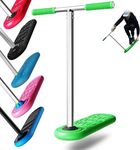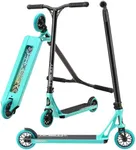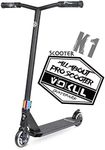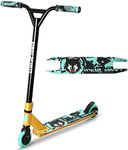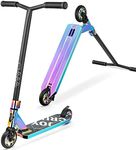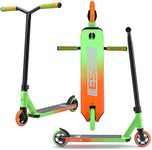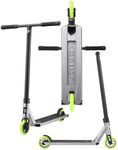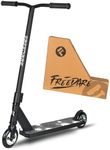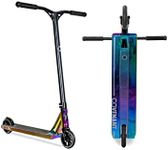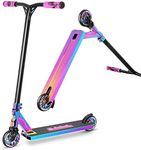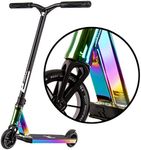Buying Guide for the Best Trick Scooters
Choosing the right trick scooter is all about matching the scooter’s features to your riding style, skill level, and the types of tricks you want to perform. Trick scooters, also known as stunt scooters, are designed to withstand the impacts and stresses of jumps, spins, and grinds at skateparks or on the street. When shopping, focus on the build quality, weight, and specific components that affect performance and durability. Understanding the key specifications will help you find a scooter that feels comfortable, safe, and fun for your needs.Deck Size and MaterialThe deck is the platform you stand on, and its size and material are crucial for both comfort and performance. A wider and longer deck offers more foot space and stability, which is great for beginners or riders with larger feet, while a narrower, shorter deck is lighter and easier to maneuver for advanced tricks. Decks are usually made from aluminum for a good balance of strength and weight. If you’re just starting out or prefer cruising, a larger deck might suit you, but if you’re focused on technical tricks, a smaller, lighter deck can make spins and flips easier.
Bar Height and WidthThe handlebars, or bars, affect your control and comfort. Bar height should generally reach somewhere between your waist and hips when standing on the scooter, giving you enough leverage for tricks without being unwieldy. Wider bars offer more stability and control, while narrower bars are lighter and easier to spin. If you’re taller, look for higher bars; if you like doing bar spins and quick tricks, a slightly narrower bar might be better.
Wheel Size and HardnessWheels on trick scooters are usually smaller and harder than those on regular scooters, which makes them faster and more responsive for tricks. Common sizes range from 100mm to 120mm in diameter. Smaller wheels are lighter and accelerate quickly, making them ideal for technical tricks, while larger wheels roll smoother and are better for speed and stability. Harder wheels last longer and slide more easily for grinds, but can feel rougher on uneven surfaces. Choose based on whether you prioritize speed and smoothness or agility and trick performance.
Compression SystemThe compression system holds the scooter’s fork, bars, and deck together, affecting how solid and smooth the scooter feels. There are several types, like IHC, HIC, and SCS, each with different strengths. Simpler systems are easier to maintain and lighter, which is good for beginners, while more advanced systems offer better durability and smoother performance for experienced riders who do big tricks. If you’re new, a basic system is fine, but as you progress, you might want a more robust compression setup.
WeightThe overall weight of the scooter impacts how easy it is to perform tricks. Lighter scooters are easier to lift, spin, and flip, making them ideal for technical tricks and younger riders. Heavier scooters can feel more stable and durable, which is helpful for bigger jumps and rougher use. Think about your strength and the types of tricks you want to do—if you’re focused on learning spins and flips, go lighter; if you want something that can take a beating, a bit more weight might be better.
Fork TypeThe fork connects the front wheel to the bars and deck, and its design affects compatibility with wheel sizes and the scooter’s overall strength. Threaded forks are simpler and found on entry-level scooters, while threadless forks are stronger and used on higher-end models. If you plan to upgrade parts or use larger wheels, make sure the fork is compatible. For most beginners, a standard fork is fine, but if you’re advancing, look for a threadless fork for better performance and durability.
